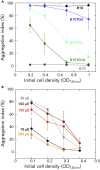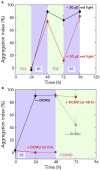Blue-/Green-Light-Responsive Cyanobacteriochromes Are Cell Shade Sensors in Red-Light Replete Niches
- PMID:32146329
- PMCID: PMC7063230
- DOI: 10.1016/j.isci.2020.100936
Blue-/Green-Light-Responsive Cyanobacteriochromes Are Cell Shade Sensors in Red-Light Replete Niches
Abstract
Cyanobacteriochrome (CBCRs) photoreceptors show various photochemical properties, but their ecophysiological functions remain elusive. Here, we report that the blue/green CBCRs SesA/B/C can serve as physiological sensors of cell density. Because cyanobacterial cells show lower transmittance of blue light than green light, higher cell density gives more green-light-enriched irradiance to cells. The cell-density-dependent suppression of cell aggregation under blue-/green-mixed light and white light conditions support this idea. Such a sensing mechanism may provide information about the cell position in cyanobacterial mats in hot springs, the natural habitat of Thermosynechococcus. This cell-position-dependent SesA/B/C-mediated regulation of cellular sessility (aggregation) might be ecophysiologically essential for the reorganization and growth of phototrophic mats. We also report that the green-light-induced dispersion of cell aggregates requires red-light-driven photosynthesis. Blue/green CBCRs might work as shade detectors in a different niche than red/far-red phytochromes, which may be why CBCRs have evolved in cyanobacteria.
Keywords: Biological Sciences; Microbiology; Sensor.
Copyright © 2020 The Author(s). Published by Elsevier Inc. All rights reserved.
Conflict of interest statement
Declaration of Interests The authors declare no competing interests.
Figures





References
- Anders K., Essen L.O. The family of phytochrome-like photoreceptors: diverse, complex and multi-colored, but very useful. Curr.Opin.Struct. Biol. 2015;35:7–16. - PubMed
- Bolhuis H., Cretoiu M.S., Stal L.J. Molecular ecology of microbial mats. FEMS Microbiol. Ecol. 2014;90:335–350. - PubMed
- Cho S.M., Jeoung S.C., Song J.Y., Kupriyanova E.V., Pronina N.A., Lee B.W., Jo S.W., Park B.S., Choi S.B., Song J.J., Park Y.I. Genomic survey and biochemical analysis of recombinant candidate cyanobacteriochromes reveals enrichment for near UV/violet sensors in the halotolerant and alkaliphilic cyanobacterium Microcoleus IPPAS B353. J. Biol. Chem. 2015;290:28502–28514. - PMC - PubMed
- Enomoto G., Hirose Y., Narikawa R., Ikeuchi M. Thiol-based photocycle of the blue and teal light-sensing cyanobacteriochrome Tlr1999. Biochemistry. 2012;51:3050–3058. - PubMed
LinkOut - more resources
Full Text Sources
